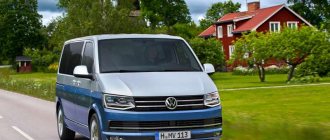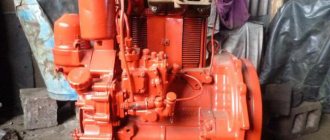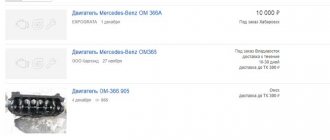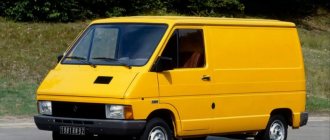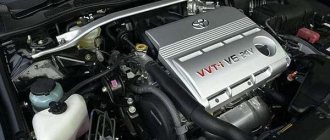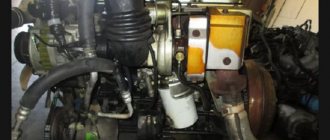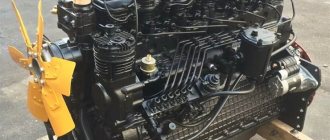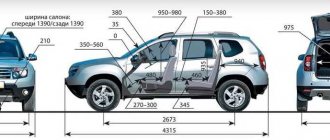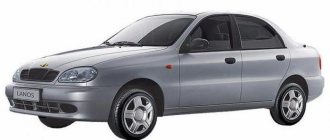Brief characteristics of the T4 Conveyor family
Strict and conservative, simple and practical, the Volkswagen Transporter T4 has appealed to consumers all over the world. This is one of the most popular vans of this class of all time in Europe. Over the years of production of this model, more than ten million of these cars were sold!
A wide selection of modifications, configurations and complete sets of the T4 Transporter made it popular among traders or middle-class businessmen (using it as a working delivery van); and among people who buy a multifunctional car for recreation and travel.
The popularity of the Transporter T4 as a “people’s” van in Russia can be the envy of most manufacturers of commercial light-duty vehicles - the number of T4s in our country exceeds 100 thousand vehicles (according to the analytical agency Autostat). This is only data on the T4, and the Russians also use the older, but still functional rear-wheel drive T3, and the more modern Transporter T5.
The predominance of cars produced in the 1990s demonstrates that our compatriots purchased them second-hand. Before the increase in customs duties, there were times when the T4 Transporter was brought from Europe in orderly columns.
Most T4 is in the central and northwestern regions. There is also a wide selection of them on the secondary market. In the Far East, Volkswagen is exotic, which is not surprising: the Japanese have long reigned supreme there.
In general, despite the extremely oversaturated competition in the class of light commercial vehicles, the Volkswagen Transporter T4 throughout its history has confidently surpassed in popularity most of its competitors - Europeans, Japanese, and Koreans.
Because, despite the relatively high maintenance costs, the Volkswagen Transporter T4 light-duty vans have proven to be very profitable to operate – largely thanks to their fuel-efficient engines, which provide an excellent cost-performance ratio with low fuel consumption.
In addition, as the authoritative magazine “Behind the Wheel” notes, “not the least advantage of this car is the hassle-free availability of spare parts. Today, the Volkswagen Transporter can be repaired even in a remote village. At the same time, it is not necessary to look for a part specifically for it - many things fit from Volkswagen cars, which are also replicated in millions of copies.
The name Transporter can be understood as any commercial vehicle Volkswagen T series, since they are all close relatives.
This generalization can be called forced. Because if you list all the names under which these cars officially rolled off the factory assembly lines each time, the article will take up a lot of space. It is difficult to find another car with such a complex and extensive designation scheme.
For example, since 1998, the company stopped using the name Transporter for the passenger versions of Caravelle and Multivan - it separated them (not technically, but purely formally) into independent models with their own families, but left them with the previous designation of the car generation - T4. And similar marketing decisions.
Volkswagen Transporter T4 variants
It was the fact that a huge number of modifications were created on the common basis of this family that became the reason for the enormous popularity of the model. Without going into details of each of them, we will highlight the main varieties: passenger, cargo, cargo-passenger.
Each of them was produced with a short (standard SWB) or long LWB wheelbase; with different roof options - standard, Aufstell and high roof. The cheapest modification of the Volkswagen Transporter is an all-metal van without windows.
There are so many options for equipping and finishing the Transporter T4 that there are complete opposites: economy class Transporters can be so “poor” that even a Gazelle will seem more luxurious. And there are such special configurations, the degree of comfort in which is simply off the charts. Here, everyone has their own needs: one needs a luxury interior, and most buyers need a spacious cargo area. At the same time, in all versions of the T4 Transporter, the seats in the cabin can be removed if desired.
Modifications within the extensive family include the following options:
- Panel Vans - no windows behind the C-pillar, with a single row of seats.
- EuroVan – with two side windows.
- Combi-Van – with additional windows between the B and C pillars and two rows of seats.
- Caravelle – minibuses with 5, 7, 8, 9 seats.
- Single Cab Pickup – pickups with a standard cab, based on the standard SWB chassis.
- Double Cab Pickup – pickups with a double cab, based on an extended LWB chassis.
- Syncro 4×4 – all-wheel drive option.
In addition to cargo, passenger and cargo-passenger versions, recreational vehicles were produced on the basis of the Volkswagen Transporter T4 in three versions, as well as a full-fledged motor home, mobile office, etc.
During 1990-1995 several changes were made to the model that did not in any way affect the appearance of the car; The range of gasoline and diesel engines for the T4 was expanded.
In 1996, the only deep reconstruction of this model was carried out. Changes included rear disc brakes, a one-piece rear bumper, and new 2.5-liter TDI diesel engines.
The exterior restyling provided the Transporter T4 with a different cladding for the front of the vehicle. You can also distinguish between pre- and post-restyling cars by the air intake gills on the right wing - there were none before 1996.
The Caravelle VR6 was launched with a longer bonnet, a new variant of the new engine layout.
In most cases, the Transporter T4 purchased by Russians on the secondary market was assembled at a plant in Hannover, Germany, where all modifications of the T4 were produced, except for flatbed trucks and universal chassis. Because a plant in the Polish city of Poznan specialized in T4 “tadpoles”. But, in addition to flatbed trucks and chassis, inexpensive versions of Volkswagen Transporter T4 vans were also assembled there.
In the summer of 2003, the Volkswagen concern completed production of the Transporter T4 and switched to mass production of the new generation T5 light-duty vehicles.
Design Features
The body of Volkswagen Transporter T4 vans and minibuses is load-bearing. Flatbed “tadpole” trucks and universal chassis for installing special bodies are built on a spar frame.
There are two wheelbase options for the Transporter T4 - 2920 and 3320 mm, and two main roof height options - 1940 or 2430 mm. But! The short-wheelbase Transporter T4 with a high roof was not produced.
The front suspension of the car is torsion bar, based on wishbones, MacPherson type. And the rear suspension is spring, on trailing arms, with shortened coil springs and telescopic shock absorbers.
The steering mechanism of the Transporter T4 is rack and pinion. Power steering was immediately included in the basic configuration of any variant of this car. Just like ABS - anti-lock braking system. The driving experience is almost like a car.
The dynamics of the car, of course, are by no means car-like, and on the whole are quite low. However, the independent suspension on all wheels makes you feel: the T4 handles noticeably better than many other commercial vehicles like it.
The standard tire size for Volkswagen Transporter T4 cars is 215/60 R16 H, and the size of their rims is R16. The normal place for a spare wheel is under the floor of the body, on the street. It’s dirty, of course, but the interior space of the van’s cargo compartment is not “eaten up.”
Possibilities for cargo transportation
Depending on the vehicle version, the standard volume of capacity of an all-metal Volkswagen Transporter T4 van can be 5.4 - 6.3 - 7.8 cubic meters. Standard load capacity, according to the passport: 800 - 1000 - 1200 kg. The flatbed tadpole truck Transporter T4 takes 1410 kg according to its passport.
In this case, the total weight of the vehicle is up to 2.5-2.8 tons. Access to the cargo compartment is very easy. Firstly, thanks to the large doors - sliding side and hinged rear doors with a wide opening angle. Secondly, thanks to the very low loading/unloading height: it is only 51.5 cm. At the same time, the standard ground clearance of the Volkswagen Transporter T4 is 180 mm.
Specifications
By the nature of its operation, despite the overall dimensions of the Volkswagen Transporter T4, it is a passenger car: maneuverable, compact and lightweight. Along with this, the VW T4 is equipped with a chassis with a high margin of safety and excellent maintainability. The dimensions of the Volkswagen Transporter T4 depend on the body type, which is usually divided into three types:
- Passenger - up to 9 seats.
- Cargo-passenger - 3-5 seats.
- Cargo - 3 places.
The curb weight of the vehicle is 1580 kg. The permissible loading weight must not exceed 2580 kg. For the Volkswagen Transporter, body dimensions vary over a wide range, which determines the body type:
- width: large - 1840 mm, reduced - 1620 mm;
- length: standard - 5107 mm, reduced - 4789 mm;
- height: standard - 1900 mm, reduced - 1350 mm, increased - 1940 mm.
As already mentioned, VW models are highly resistant to corrosion. This is achieved thanks to the technology of aging steel after stamping, galvanizing parts and using mixtures to increase the adhesion of the paint and varnish coating to the metal surface.
Car engines Volkswagen Transporter T4
Cars of the Volkswagen Transporter T4 family were equipped with gasoline engines with a displacement of 2.0, 2.5, 2.8 liters, or diesel engines with a displacement of 1.9, 2.4, 2.5 liters. The power range of this wide range of engines is huge - from 61 hp. (45 kW) up to 151 hp (111 kW). The volume of the standard fuel tank is 80 liters.
Diesel options have traditionally proven to be more economical and profitable. The range of engines included turbocharged direct injection power units: 2.5-liter TDI diesel engines. Cars equipped with them were and still are more expensive.
Overall, all Transporter T4 engines are very reliable and durable (subject to normal use and maintenance).
Engine and gearbox T4
In this generation of transporters, diesel engines began to be installed. In addition, the engine has moved forward, like most manufacturers.
Motors are presented in models with powers of 60-115 hp. 4-5 cylinders.
Diesel
Powerful and at the same time economical, diesel engines are optimal for traveling and any trips on bad roads, with a lot of descents and ascents.
The line of T4 engines is represented by units of 1.9 - 2.5 liters. With a power of 60-102 hp.
Read also Volkswagen SP2 review
The minimum fuel consumption at a speed of 90 km/h is 8.9 liters, the maximum is 9.4.
Petrol
Gasoline engines are more reliable, break down less often, and are designed for longer mileage. Speeds of up to 164 km/h are available with them.
Presented in 2 and 2.5 liter models with a power of 84 and 115 hp.
At the same time, fuel consumption is higher./span>
5-speed manual transmission. Automation was also installed on the latest models.
Tires
Transporter tires were developed for each type of model separately. This part of the package has been constantly improved, so for the optimal choice you need to take into account several factors:
- car brand
- year of issue
- engine volume - modifications to the brake system and other technical characteristics are often associated with it.
Volkswagen Transporter T4 transmission
The gearbox of the Volkswagen Transporter T4 is a five-speed manual transmission or a four-speed automatic. The vast majority of Volkswagen Transporter T4 presented in Russia are equipped with a manual transmission, while automatic transmission is exotic.
All-wheel drive transmission The T4 4x4 conveyor structurally consists of an angular gearbox in the section of the right front axle shaft, a driveshaft and a rear gearbox with CV joint drives. The viscous coupling is activated when the front wheels slip and supplies torque to the rear wheels.
Technical characteristics of Volkswagen Transporter T4
contents
Model VW Transporter T4 is a modern unit with a full set of new developments. It was produced from 1990 to 2003. Technical characteristics of the Volkswagen Transporter T4 have undergone changes in all respects over the course of 13 years of production. The car is represented by the largest number of models, varying in:
- engine power and fuel type;
- configurations;
- purpose.
This model range was discontinued 15 years ago, but despite this, you can find cars with 25 years of service in excellent condition. In addition to the owner’s good care of his equipment, this is due to the excellent corrosion protection of the body. This is especially noticeable in the example if we consider which is better: Volkswagen Transporter or Ford Transit. The latter, which is not inferior in its parameters to VW, has 2 drawbacks: rapid corrosion of the body and poor supply of spare parts. And only thanks to constructive continuity, VW models are free of all these shortcomings, despite the fact that they have been out of production for 15 years.
Another pleasant bonus will be the opportunity to find out that the cars produced by the concern in the period 1990-2000 have a high margin of safety, and many buyers prefer the 4th generation model when choosing.
Volkswagen Transporter T4
